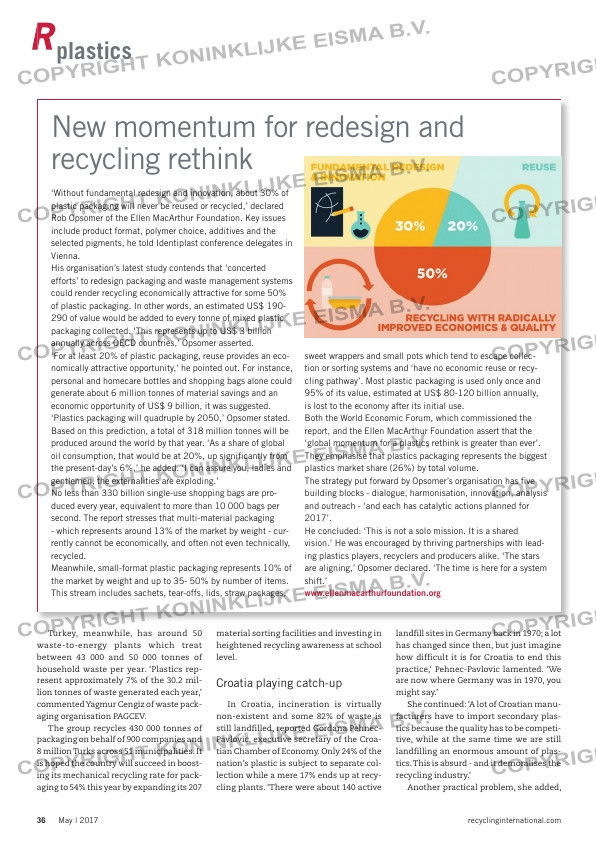Page 38 from: Edition 3 2017

36 May | 2017
plastics
recyclinginternational.com
Turkey, meanwhile, has around 50
waste-to-energy plants which treat
between 43 000 and 50 000 tonnes of
household waste per year. ‘Plastics rep-
resent approximately 7% of the 30.2 mil-
lion tonnes of waste generated each year,’
commented Yagmur Cengiz of waste pack-
aging organisation PAGCEV.
The group recycles 430 000 tonnes of
packaging on behalf of 900 companies and
8 million Turks across 51 municipalities. It
is hoped the country will succeed in boost-
ing its mechanical recycling rate for pack-
aging to 54% this year by expanding its 207
material sorting facilities and investing in
heightened recycling awareness at school
level.
Croatia playing catch-up
In Croatia, incineration is virtually
non-existent and some 82% of waste is
still landfilled, reported Gordana Pehnec-
Pavlovic, executive secretary of the Croa-
tian Chamber of Economy. Only 24% of the
nation’s plastic is subject to separate col-
lection while a mere 17% ends up at recy-
cling plants. ‘There were about 140 active
landfill sites in Germany back in 1970; a lot
has changed since then, but just imagine
how difficult it is for Croatia to end this
practice,’ Pehnec-Pavlovic lamented. ‘We
are now where Germany was in 1970, you
might say.’
She continued: ‘A lot of Croatian manu-
facturers have to import secondary plas-
tics because the quality has to be competi-
tive, while at the same time we are still
landfilling an enormous amount of plas-
tics. This is absurd – and it demoralises the
recycling industry.’
Another practical problem, she added,
New momentum for redesign and
recycling rethink
‘Without fundamental redesign and innovation, about 30% of
plastic packaging will never be reused or recycled,’ declared
Rob Opsomer of the Ellen MacArthur Foundation. Key issues
include product format, polymer choice, additives and the
selected pigments, he told Identiplast conference delegates in
Vienna.
His organisation’s latest study contends that ‘concerted
efforts’ to redesign packaging and waste management systems
could render recycling economically attractive for some 50%
of plastic packaging. In other words, an estimated US$ 190-
290 of value would be added to every tonne of mixed plastic
packaging collected. ‘This represents up to US$ 3 billion
annually across OECD countries,’ Opsomer asserted.
‘For at least 20% of plastic packaging, reuse provides an eco-
nomically attractive opportunity,’ he pointed out. For instance,
personal and homecare bottles and shopping bags alone could
generate about 6 million tonnes of material savings and an
economic opportunity of US$ 9 billion, it was suggested.
‘Plastics packaging will quadruple by 2050,’ Opsomer stated.
Based on this prediction, a total of 318 million tonnes will be
produced around the world by that year. ‘As a share of global
oil consumption, that would be at 20%, up significantly from
the present-day’s 6%,’ he added. ‘I can assure you, ladies and
gentlemen, the externalities are exploding.’
No less than 330 billion single-use shopping bags are pro-
duced every year, equivalent to more than 10 000 bags per
second. The report stresses that multi-material packaging
– which represents around 13% of the market by weight – cur-
rently cannot be economically, and often not even technically,
recycled.
Meanwhile, small-format plastic packaging represents 10% of
the market by weight and up to 35- 50% by number of items.
This stream includes sachets, tear-offs, lids, straw packages,
sweet wrappers and small pots which tend to escape collec-
tion or sorting systems and ‘have no economic reuse or recy-
cling pathway’. Most plastic packaging is used only once and
95% of its value, estimated at US$ 80-120 billion annually,
is lost to the economy after its initial use.
Both the World Economic Forum, which commissioned the
report, and the Ellen MacArthur Foundation assert that the
‘global momentum for a plastics rethink is greater than ever’.
They emphasise that plastics packaging represents the biggest
plastics market share (26%) by total volume.
The strategy put forward by Opsomer’s organisation has five
building blocks – dialogue, harmonisation, innovation, analysis
and outreach – ‘and each has catalytic actions planned for
2017’.
He concluded: ‘This is not a solo mission. It is a shared
vision.’ He was encouraged by thriving partnerships with lead-
ing plastics players, recyclers and producers alike. ‘The stars
are aligning,’ Opsomer declared. ‘The time is here for a system
shift.’
www.ellenmacarthurfoundation.org



